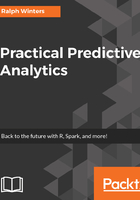
Clustering
Clustering is a method which groups data into different classes, so that each class is similar to each other. There are various methods that can be used to define similarity. K-Means clustering is probably the most popular method of clustering. This method uses distances measured to assign data observations to the closest class. Clustering is often used in marketing in order to develop different customer segments.
Clustering is an unsupervised algorithm and is subjective. You can specify beforehand how many groups you wish to cluster into. This number is somewhat arbitrary, and if the goal is interpretability, it can yield to different interpretations.
Scatterplots are often used to show data clusters using only two variables (one is on the x axis and the other on the y axis).
Here is an example of some scatterplots which can be used to pick out clusters by seeing which data points congregate together.

The plot on the right shows five distinct clusters. You can see that very low values of variable x tend to go with very low values of variable y. However, it is a bit unclear what the clusters should be for the plot on the left. Sometimes low values of x go with low values of y, but sometimes they are associated with high values of y. There is no apparent distinct grouping. What do you see? Do you see two clusters, three or more, or no clustering? It is really impossible to tell and that is where subjectivity creeps in.